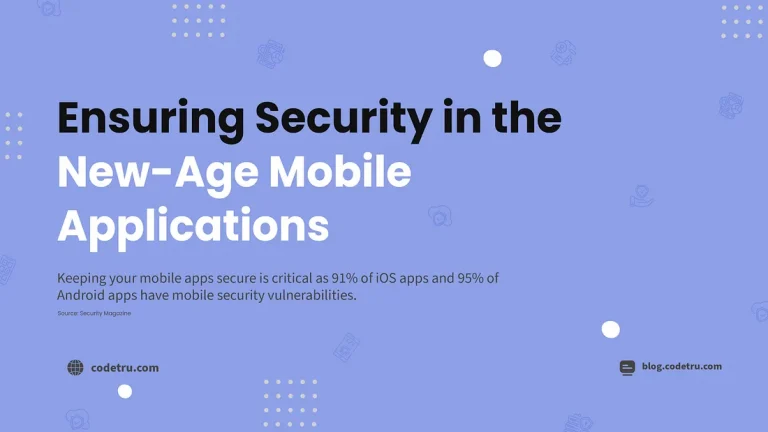In today’s digital age, mobile applications have become an integral part of our lives. They offer convenience, entertainment, and countless possibilities at our fingertips. However, with great power comes great responsibility, and that responsibility extends to both businesses and users. Mobile app security is a paramount concern, as it safeguards sensitive data and ensures a smooth user experience. In this blog, we will explore the importance of mobile app security, highlight common risks and threats, and present best practices to ensure your mobile app is as secure as possible.
Why Mobile App Security Matters
Mobile app security is a top priority for businesses and users alike. Let’s start by understanding why it’s so crucial.
For Businesses
1. Protecting Brand Reputation: Security breaches can tarnish a company’s reputation. In the age of social media and instant communication, a single breach can lead to a PR disaster.
2. Compliance: Many industries are subject to data protection regulations. Failing to secure user data can lead to hefty fines and legal repercussions.
3. Customer Trust: Users are more likely to engage with and trust apps that prioritize their security. Secure apps lead to more downloads and higher user retention rates.
4. Financial Implications: A data breach can result in significant financial losses, including legal fees, fines, and compensation to affected users.
For Users
1. Data Protection: Users store a vast amount of personal and sensitive data on their mobile devices. This includes everything from contact information to financial details. Mobile app security is essential to protect this data from unauthorized access.
2. Identity Theft: If an app is not secure, it can expose users to identity theft and financial fraud.
3. Malware and Phishing: Insecure apps can be exploited to spread malware or serve as platforms for phishing attacks.
4. Privacy: Mobile apps often request access to a user’s location, camera, and other sensitive data. Without proper security measures, this data can be exposed without consent.
Common Risks and Threats
To understand the gravity of mobile app security, we need to be aware of the common risks and threats that mobile apps face:
1. Data Breaches: Unauthorized access to user data is a significant risk. In 2021 alone, there were 1,862 reported data breaches worldwide, exposing billions of records.
2. Malware: Malicious software can infiltrate mobile apps, potentially causing havoc. In 2020, mobile malware attacks increased by 50%.
3. Phishing: Cybercriminals often use mobile apps to lure users into sharing their personal and financial information. Since the beginning of 2019, the number of phishing attacks has grown by more than 150% per year.
Now that we understand the importance of mobile app security and the risks involved, let’s explore some best practices to ensure your app is safe for both businesses and users.
Mobile App Security Best Practices
1. Run a Security Check
A security check can reveal weak points in your app’s architecture, allowing you to fortify your defenses before malicious acts exploit it for any vulnerabilities.
Before you release your app to the public, you should perform a security check to identify and fix any vulnerabilities or issues that may affect your app’s security. A security check is a comprehensive assessment of your app’s security posture, covering various aspects such as code quality, data protection, network communication, authentication, authorization, encryption, etc.
There are various tools and services that can help you perform a security check for your mobile app. One of them is Astra’s Pentest & VAPT, which is a professional and automated service that can scan your app for over 1000 vulnerabilities and provide you with detailed reports and recommendations. Astra’s Pentest & VAPT can help you prevent data leaks, comply with regulations such as GDPR or PCI DSS, and improve your app’s security rating.
Running a security check before releasing your app can help you identify and fix vulnerabilities, prevent data leaks, and comply with regulations.
2. Keep the Code Safe
One of the most important aspects of mobile app security is keeping your code safe from unauthorized access, modification, or theft. Your code contains valuable information and logic that can be exploited by cybercriminals to create fraudulent versions of your app or introduce malware into it.
To keep your code safe, you should use techniques such as encryption, obfuscation, and code signing. Encryption is the process of transforming your code into an unreadable format that can only be decrypted by authorized parties. Obfuscation is the process of making your code more complex and difficult to understand by changing its structure, names, or logic. Code signing is the process of attaching a digital signature to your code that verifies its authenticity and integrity.
Using these techniques can help you protect your code from unauthorized access, modification, or theft.
3. Perform Routine Security Audits
Another best practice for ensuring security in your mobile app is performing routine security audits. A security audit is a periodic review and evaluation of your app’s security performance and compliance. A security audit can help you detect and resolve new or emerging threats, as well as maintain user trust and satisfaction.
There are various tools and services that can help you perform routine security audits for your mobile app. Some examples are OWASP ZAP and Nmap. OWASP ZAP is an open-source tool that can help you test the security of your web applications by finding vulnerabilities such as SQL injection, cross-site scripting (XSS), broken authentication, etc. Nmap is a free tool that can help you scan your network for hosts, ports, services, firewalls, etc.
Performing routine security audits can help you monitor and improve your app’s security performance and compliance.
4. Test Internally and Hire Experts
Another best practice for ensuring security in your mobile app is testing it internally for security issues before releasing it to the public. Testing internally can help you ensure your app’s functionality and reliability, as well as reduce the risk of errors or bugs.
There are various methods that you can use to test your app internally for security issues, such as unit testing, integration testing, and penetration testing. Unit testing is the process of testing individual components or units of your code for functionality and correctness. Integration testing is the process of testing how different components or units of your code work together. Penetration testing is the process of simulating real-world attacks on your app to find and exploit vulnerabilities.
Testing internally can help you ensure your app’s functionality and reliability, as well as reduce the risk of errors or bugs.
However, testing internally may not be enough to cover all the possible scenarios and perspectives that may affect your app’s security. Therefore, you should also consider hiring external experts for security consultation or assistance. External experts can provide you with valuable insights and feedback, as well as leverage their skills and experience to help you improve your app’s security.
There are various platforms and services that can help you hire external experts for security consultation or assistance, such as HackerOne and Bugcrowd. HackerOne and Bugcrowd are platforms that connect you with a network of ethical hackers who can help you find and fix vulnerabilities in your app through bug bounty programs or vulnerability disclosure programs.
Hiring external experts can help you gain valuable insights and feedback, as well as leverage their skills and experience to improve your app’s security.
5. Define Security Standards and Processes
The last best practice for ensuring security in your mobile app is defining clear and consistent security standards and processes for your app development and maintenance. Security standards and processes are guidelines and procedures that help you ensure compliance with best practices and regulations, as well as improve your app’s quality and reputation.
There are various frameworks and resources that can help you define security standards and processes for your mobile app, such as ISO 27001 and NIST SP 800–53. ISO 27001 is an international standard that specifies the requirements for establishing, implementing, maintaining, and improving an information security management system (ISMS). NIST SP 800–53 is a publication that provides a catalog of security and privacy controls for federal information systems and organizations.
Defining security standards and processes can help you ensure compliance with best practices and regulations, as well as improve your app’s quality and reputation.
Conclusion
In summary, mobile app security is a critical concern for both businesses and users. Protecting sensitive data and ensuring a secure user experience should be at the forefront of app development. By following the best practices outlined in this blog, you can significantly reduce the risk of security breaches and cyberattacks.
Remember, mobile app security is an ongoing commitment. Prioritizing security not only safeguards your business but also protects the trust and privacy of your users in an increasingly interconnected world. visit mobile app development services for more
5 FAQs on Ensuring Security in New-age Mobile Applications
1. What are the common security threats to new-age mobile applications?
Common security threats to new-age mobile applications include data breaches, unauthorized access, malware, and insecure data storage. Other threats involve insecure communication channels and vulnerabilities in third-party libraries. Ensuring robust mobile app security measures and regular security assessments can help mitigate these risks.
2. How can developers protect user data in mobile applications?
Developers can protect user data by implementing strong encryption techniques, both at rest and in transit. Using secure authentication methods like multi-factor authentication (MFA), and ensuring secure API connections are also crucial. Regular security updates and compliance with data protection regulations are key to safeguarding user data in mobile applications.
3. What role does secure coding play in mobile app security?
Secure coding practices are essential for preventing vulnerabilities in mobile applications. This includes validating user inputs, avoiding hard-coded credentials, and implementing proper error handling. Following secure coding guidelines helps in developing robust mobile apps that resist common attacks like SQL injection and cross-site scripting (XSS).
4. How can mobile apps ensure secure communication?
Mobile apps can ensure secure communication by using HTTPS for all data exchanges and implementing strong encryption protocols. Techniques like certificate pinning and secure token management also contribute to protecting data integrity and confidentiality during transmission. Leveraging secure communication methods is vital for maintaining the security of mobile applications.
5. What are the best practices for mobile app developers to follow for enhanced security?
Best practices for mobile app developers include conducting regular security audits, using secure coding practices, employing encryption for sensitive data, and ensuring up-to-date libraries and frameworks. Additionally, integrating security testing tools and fostering a culture of security awareness among the development team are crucial for enhancing mobile app security.







